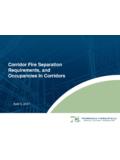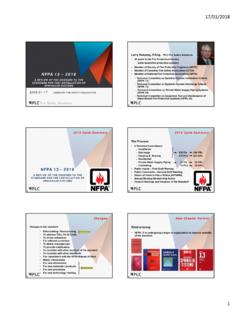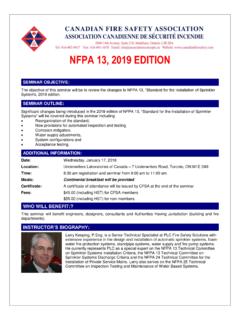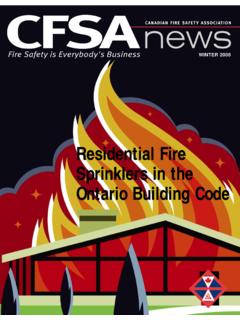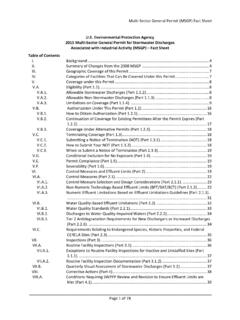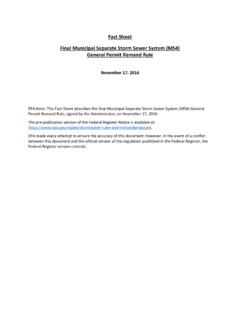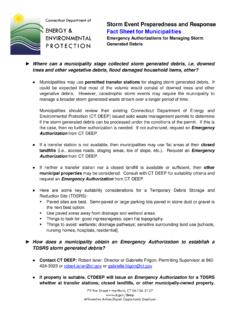Transcription of Phase-out and Disposal of Halons in Fire …
1 Ozone Protection Programs, fact sheet No. 2009-02. Phase-out and Disposal of Halons in fire - extinguishing Systems in canada This fact sheet aims to inform owners of halon fire - extinguishing systems and personnel servicing these systems of the Phase-out requirements and Disposal options for these systems in canada . Controls on Manufacture, Import and Export of Halons The federal Ozone-depleting Substances Regulations, 1998 (ODSR 1998) regulate the manufacture, import and export of ozone-depleting substances (ODS), including Halons , in canada . With respect to Halons , the ODSR 1998 reaches its objective of reducing the production and consumption of ODS by: banning the manufacture, import and export of bulk new halon not allowing the import, for use in canada , of bulk used, recovered, recycled, or reclaimed halon not allowing the export of Halons to another country except for essential purposes, reclamation or destruction prohibiting the manufacture and import of products that contain or are designed to contain Halons (such as fire - extinguishing systems) except for use in aircraft, military ships or military vehicles The ODSR 1998 allows for some exceptions to the first three prohibitions described above, however only if authorized under a permit issued by Environment canada .
2 Further information on these exceptions, the permitting process, and importing and exporting Halons and halon - containing products may be obtained by contacting Environment canada 's Ozone Protection Programs (contact information is found on page 5). Controls on Use and Handling of Halons In addition to being ozone-depleting substances, Halons are greenhouse gases. In order to reduce and prevent emissions of Halons in canada , the use and handling of Halons are regulated by the provinces/territories in their respective jurisdictions, and through the Federal Halocarbon Regulations, 2003 (FHR 2003) for systems under federal jurisdiction. If a halon fire - extinguishing system is not subject to the FHR 2003, it falls under provincial/territorial jurisdiction and is subject to the applicable provincial or territorial regulations.
3 Important note for fire - extinguishing systems regulated under the FHR 2003: The Federal Halocarbon Regulations 1999, which preceded the FHR 2003, prohibited the installation of halon fire - extinguishing systems, unless authorized to do so by a permit issued by Environment canada . The FHR 2003 include a similar prohibition. halon fire - extinguishing systems that were installed before these prohibitions were put in place can continue to operate, however there are restrictions on recharging these systems: - Portable systems: It is prohibited to charge a portable system with halon , except for use on an aircraft, military vehicle or military ship, or unless authorized to do so by a permit issued under the FHR 2003. - Non-portable ( fixed) systems: After December 31st, 2009, the one-time charging allowance provided for in of the FHR 2003 for fixed systems no longer applies, and therefore a fixed system cannot be charged with halon , except for use on aircraft, military vehicle or military ship, or unless authorized to do so by a permit under the FHR 2003.
4 For information regarding requirements for fire - extinguishing systems under the federal jurisdiction, contact Environment canada 's Ozone Protection Programs (see page 5). Link to the FHR 2003: fire - extinguishing systems regulated under the provinces/territories: Provincial/territorial requirements may differ from those prescribed in the FHR 2003. For information regarding requirements for systems under provincial or territorial jurisdiction, please contact the appropriate authority in your region. Contact information is available at the following link: Links to Provincial and Territorial Acts and Regulations on halocarbons can be found here: Page 2 of 7. The following chart will help you determine what provisions regarding Phase-out of Halons apply to your halon fire - extinguishing system (s) (section nos.)
5 Refer to the applicable FHR 2003 provisions): Is the halon fire - extinguishing system1. (fixed or portable2) located in canada and YES The system is regulated under owned by: Her Majesty in right of canada , a the FHR 2003. Federal government department, board or agency? A Crown corporation? or Release of halon from a fire - A Federal work or undertaking as extinguishing system or its defined in the Canadian Environmental associated equipment is Protection Act, 1999? prohibited, except: to fight a fire that is not set for training purposes; or NO from a purge system that is 99% efficient. [ (b)]. Is the system located on federal land or aboriginal land? YES. (Regardless of who owns the Cannot install a halon system system , including private sector unless authorized to do so by a companies and contractors) permit issued under the FHR.
6 2003. [ (1)]. NO. Cannot charge a system with halon , except for use on aircraft, The system is not regulated military vehicle or military ship, or under the FHR 2003. unless authorized to do so by a permit under the FHR 2003. [ ] and [ (1)]. Provincial/territorial requirements apply contact the appropriate authorities for more information. Fixed systems Between January 1, 2005 and December 31, 2009, a fixed fire - extinguishing system may be charged once with a halon if: The owner of the system provides written notice to Environment canada within 14. days after the system is charged;. and the system no longer operates with halon one year after the day on which it was charged. [ (3)]. 1. A fire - extinguishing system means fire - extinguishing equipment, including portable or fixed equipment and any associated equipment, that contains or is designed to contain a halocarbon fire - extinguishing agent.
7 2. A portable fire extinguisher is a cylinder or cartridge that has a charging capacity of 25 kg or less and that can be carried or wheeled to the site of a fire . Page 3 of 7. Requirements for Decommissioning halon fire - extinguishing Systems and Recovery of Halons Halons must be properly recovered from decommissioned systems to prevent releases Extreme care must be taken when decommissioning a halon fire - extinguishing system to prevent releases. Before a system is decommissioned, dismantled or destroyed, the halon must be recovered in accordance with the standard Halocarbon Clean Agent Recovery and Reconditioning Equipment ( ). Additionally, work performed on halon fire - extinguishing systems must be done according to the standard The Servicing of halon and Clean Agent extinguishing Systems ( ).
8 The FHR 2003 requires that Halons be recovered, stored and transported in containers designed and manufactured to be refilled and to contain that specific type of halon . If Halons are stored, they must be contained in appropriate containers that are stored in a dry, clean environment to prevent corrosion. It is strongly recommended that storage containers be visually inspected regularly, as an additional measure to prevent releases. Containers must be stored in compliance with applicable occupational health and safety regulations and fire and building codes. Storing unwanted Halons is not advised. Refer to the next section for Disposal options. Be advised that additional requirements concerning transportation and shipping of surplus Halons may apply, including but not limited to the Transportation of Dangerous Goods Regulations.
9 Halons designated as hazardous waste are subject to further shipping requirements. It is highly recommended that Transport canada 's Transport Dangerous Goods Directorate ( ) be contacted, as well as the applicable provincial and territorial authorities (see page 4), prior to shipping surplus Halons . Guidance on Disposal of Halons Disposal options in canada halon -containing fire - extinguishing systems must be properly disposed of at the end of their useful life. Proper Disposal means having the system decommissioned and any halon recovered by a technician operating in accordance with ULC standards and halon recovered from decommissioned systems is typically either: Recycled or reclaimed for use in canada in existing fire - extinguishing systems that are exempt from the charging prohibition (aircraft, military vehicles and military ships).
10 Exported to the United States for destruction; or Exported to the United States for halon banking, which assists sellers wishing to dispose of halon in a responsible manner, and helps buyers with "critical uses" locate supplies of halon 1301 and halon 1211 for recharging their existing systems. For information on halon banking in the US, contact the US Environmental Protection Agency (US EPA) Stratospheric Ozone Information Hotline at 1-800-296-1996. halon fire - extinguishing service companies or halon recovery/recycling operations certified to ULC standards can assist in determining available Disposal options, mentioned above. For information on ULC certified companies in your area please contact the Underwriters'. Laboratories of canada (ULC): Tel: 1-866-937-3852.
